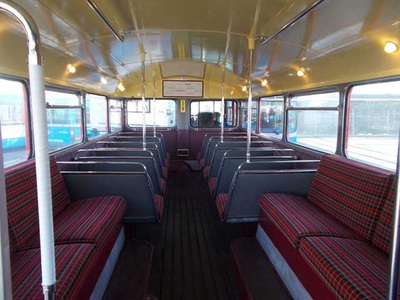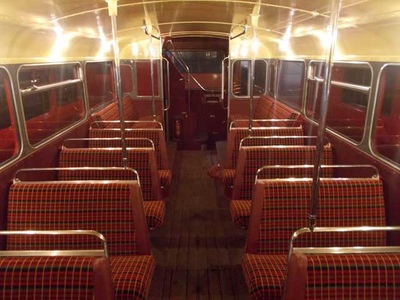Recent Photos
|
Routemaster - RM1843
Seating Capacity:
64 Special features: Original interior and engine Description:
One of London’s icons just the way you remember them! This vehicle gave sterling service in London for 23 years before it was sold to the USA ending up in Missouri. Here it languished for the next 28 years before it was saved from scrap and got running again by Ensignbus in the USA and then repatriated immediately after. A loving restoration was then carried out over the next 18 months that saw the bus return to its former glory. Now with original trim, colours, lighting and even engine for the sounds of the past, this bus is sure to evoke memories of London from a different age. Retaining its original open platform area and with a friendly conductor to greet you and your guests, this vehicle is sure to be a talking point and provoke memories from anyone who used to travel on Routemasters. Vehicle History
Routemaster Class History:
The Routemaster or RM is without doubt one of the most famous types of bus ever to run in the capital. The original necessity was for vehicles to replace the Trolleybus which was due for replacement in 1959. Following a lot of research it had been decided to increase the capacity of London’s buses from 56, such as the RT, to 64. Following numerous changes and nearly five years of development the RM finally entered service. By 1962 the entire Trolleybus fleet had been replaced almost exclusively by Routemasters. In this period RM8-879 were all built and had entered service. Increasing the length and capacity of the RM was another contentious point, with both the Unions and Met Police being against the idea. However in 1961 a batch of 24, 30’ long 72 seat versions, known as the RML or Routemaster Lengthened, were built to trial. These took the numbers of RML880-904. Following this batch, whilst the trial continued with the longer versions, production continued on the standard length RM producing numbers RM905-1452. The next version was the batch between RMC1453-1520, which were built as Routemaster Coaches (RMC). These had such delights as deeper more comfortable seats, Green Line livery, powered rear doors, twin headlamps and interior luggage racks and were far quicker. Following this batch production again returned to the standard RM which ran through from the number RM1521-2217 which became the very last standard length RM built. Following the success of the RMC’s the next batch to be built, which were by many, seen as the zenith of RM design being the RCL’s. These took the numbers from RCL2218-2260 and were built to replace the Green Line RT’s on the busy (but declining) routes from Essex into Aldgate. Similar in comfort levels to the RMC they were a longer and more powerful version Permission had now been granted to run the longer RML’s in Central London and the final production batch ran from RML2261-2760 were all built to this specification. Two batches of 50 of these RML’s were built for the Country Area and were delivered in Green being RML2306-2355 and RML2411-2460. The final type of RM to enter service with London Transport was the RMA, or Routemaster Airport, version which originally ran for British European Airways bringing passengers to and fro between Central London and Heathrow before the Underground was extended there. The Routemaster was gradually withdrawn from London in the 1980’s before a change of plan saw many of the longer versions (and some standard length ones) be refurbished in 1990-92 when they received new engines, lighting and seating. In 2000-01 some had another refurbishment where they were fitted with more environmentally friendly engines and new gear boxes. However, the policy changed in 2003 and the final 20 routes were given warning that at next change of contract the vehicles required would not be RM’s. One by one these routes were withdrawn with the very last, the 159’s, finishing on December 9, 2005. However, such is the popularity of this type of vehicle that around 16 were retained for use on two heritage routes in Central London. For more on this class why not visit Ian's Bus Stop RM1843 RM1843 was built and delivered with the Leyland engine which was instantly recognisable from its distinctive sound. It first went into service in March 1963 at Tottenham Garage where it was a regular on the routes 41, and 123 amongst others. In October 1965 it transferred to the east and moved to Walthamstow Garage, before the following year having a brief stint at Mortlake. It then went to Stamford Hill garage before heading south of the river to New Cross and Croydon before heading to Battersea and from there returning to the central works for London Transport at Aldenham for its first overhaul. Having gone through overhaul it next headed to Abbey Wood before returning south of the river and going back to New Cross Garage where it stayed until August 1976 when it went for second overhaul and was then returned to service at Willesden Garage. Only a month later was its next move, this time to Holloway where it stayed until its third and final overhaul which took place in December 1981. It left for Bow which would be its last operational garage and is where it would work until withdrawal in July 1984. It was sold by London Transport to William Jewel College, Liberty Missouri and left the UK in December 1985. It changed owners care off the college many years later and ended up in shopping mall car park in Harisonville, Missouri registered D9251-H. Faced with the threat of scrap with the parking lot being cleared the bus was acquired by Ensignbus in December 2012 and eventually arrived at Southampton on February 7, 2013 and back to Purfleet a few days later. Following an 18 month restoration it debuted back in service on the annual Ensignbus December running day in 2014. |














